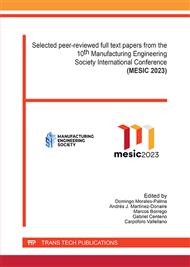[1]
NASA. (2012). The Wright Brothers' Story.
Google Scholar
[2]
Nachtigall, W., & Wisser, A. (2014). Bionics by examples : 250 Scenarios from Classical to Modern Times. In Springer.
DOI: 10.1007/978-3-319-05858-0_1
Google Scholar
[3]
du Plessis, A., Broeckhoven, C., Yadroitsava, I., Yadroitsev, I., Hands, C. H., Kunju, R., & Bhate, D. (2019). Beautiful and Functional: A Review of Biomimetic Design in Additive Manufacturing. In Additive Manufacturing (Vol. 27, p.408–427). Elsevier B.V. https://doi.org/10.1016/j.addma. 2019.03.033
DOI: 10.1016/j.addma.2019.03.033
Google Scholar
[4]
Gao, M., Li, L., Wang, Q., Ma, Z., Li, X., & Liu, Z. (2022). Integration of Additive Manufacturing in Casting: Advances, Challenges, and Prospects. In International Journal of Precision Engineering and Manufacturing - Green Technology (Vol. 9, Issue 1, p.305–322). Korean Society for Precision Engineeing
DOI: 10.1007/s40684-021-00323-w
Google Scholar
[5]
Shah, M., R.Patel, D., & Pande, S. (2022). Additive manufacturing integrated Casting- A review. Materials Today: Proceedings, 62(P13), 7199–7203
DOI: 10.1016/j.matpr.2022.03.413
Google Scholar
[6]
Schmitt, M., Michatz, M., Frey, A., Lutter-Guenther, M., Schlick, G., & Reinhart, G. (2020). Methodical software-supported, multi-target optimization and redesign of a gear wheel for additive manufacturing. Procedia CIRP, 88, 417–422
DOI: 10.1016/j.procir.2020.05.072
Google Scholar
[7]
Kamps, T., Biedermann, M., Seidel, C., & Reinhart, G. (2018). Design approach for additive manufacturing employing Constructal Theory for point-to-circle flows. Additive Manufacturing, 20, 111–118
DOI: 10.1016/j.addma.2017.12.005
Google Scholar
[8]
Hu, W. (2018). Advanced Wind Turbine Technology. In Advanced Wind Turbine Technology. Springer International Publishing
DOI: 10.1007/978-3-319-78166-2
Google Scholar
[9]
Sculpteo, & BASF. (n.d.). Metal 3D printing vs metal casting: How to choose?
Google Scholar
[10]
Michaud, J. (2022). Additive manufacturing and gears. Gear Solutions.
Google Scholar
[11]
Hamm, C. (2015). Evolution of Lightweight Structures (C. Hamm, Ed.; Vol. 6). Springer Netherlands
DOI: 10.1007/978-94-017-9398-8
Google Scholar
[12]
Potapova, M., Veselá, J., Smith, C., Minerovic, A., Aycock, L. (Editors) 2023. Diatom New Taxon File at the Academy of Natural Sciences (DNTF-ANS), Philadelphia. Retrieved on March 3, 2023, from http://dh.ansp.org/dntf
Google Scholar
[13]
Domfang Ngnekou, J. N., Nadot, Y., Henaff, G., Nicolai, J., Kan, W. H., Cairney, J. M., & Ridosz, L. (2019). Fatigue properties of AlSi10Mg produced by Additive Layer Manufacturing. International Journal of Fatigue, 119, 160–172
DOI: 10.1016/j.ijfatigue.2018.09.029
Google Scholar
[14]
Raab, M., & Bambach, M. (2023). Fatigue properties of Scalmalloy® processed by laser powder bed fusion in as-built, chemically and conventionally machined surface condition. Journal of Materials Processing Technology, 311
DOI: 10.1016/j.jmatprotec.2022.117811
Google Scholar
[15]
Dou, W., Zhang, L., Chang, H., Zhang, H., & Liu, C. (2021). Fatigue Characterization on a Cast Aluminum Beam of a High-Speed Train Through Numerical Simulation and Experiments. Chinese Journal of Mechanical Engineering (English Edition), 34(1)
DOI: 10.1186/s10033-021-00628-6
Google Scholar
[16]
Avilés Rafael, Avilés Rafael. Análisis De Fatiga En Máquinas. Madrid: Thomson; (2005).
Google Scholar
[17]
Budynas, R. G. (Richard G., Nisbett, J. Keith., & Shigley, J. Edward. (2011). Shigley's mechanical engineering design. McGraw-Hill.
Google Scholar
[18]
Ojha, A., Lai, WJ., Engler-Pinto, C., & Su, X. (2021). Notch Sensitivity of AlSi10Mg Aluminum Alloy Produced by Laser Powder Bed Fusion Process. Springer International Publishing
DOI: 10.1007/978-3-030-65261-6
Google Scholar
[19]
Pilkey, W. D., & Peterson, R. E. (1997). Peterson's stress concentration factors. Wiley.
Google Scholar
[20]
All3DP. (n.d.). Top 3D Printers Launched at Formnext 2022. Nov 18, 2022.
Google Scholar



